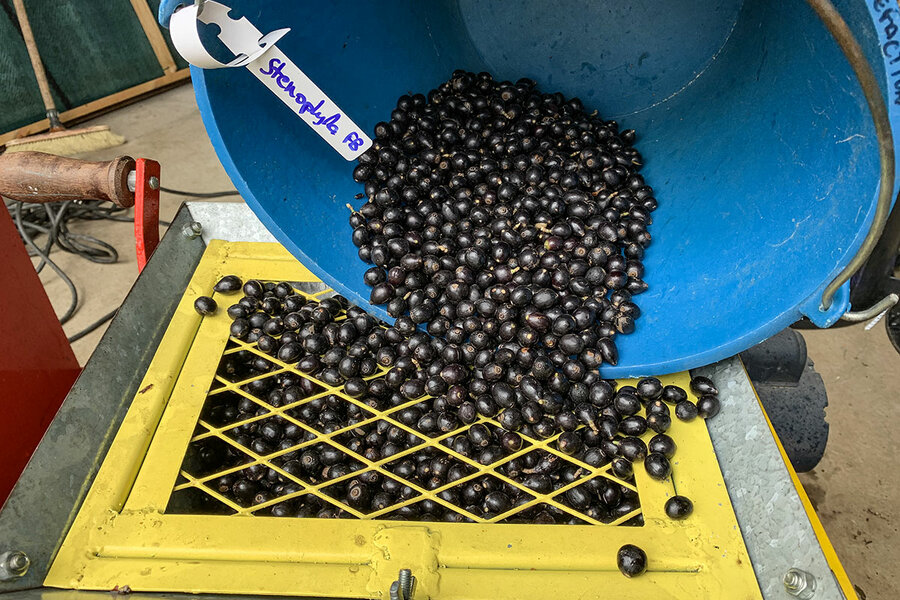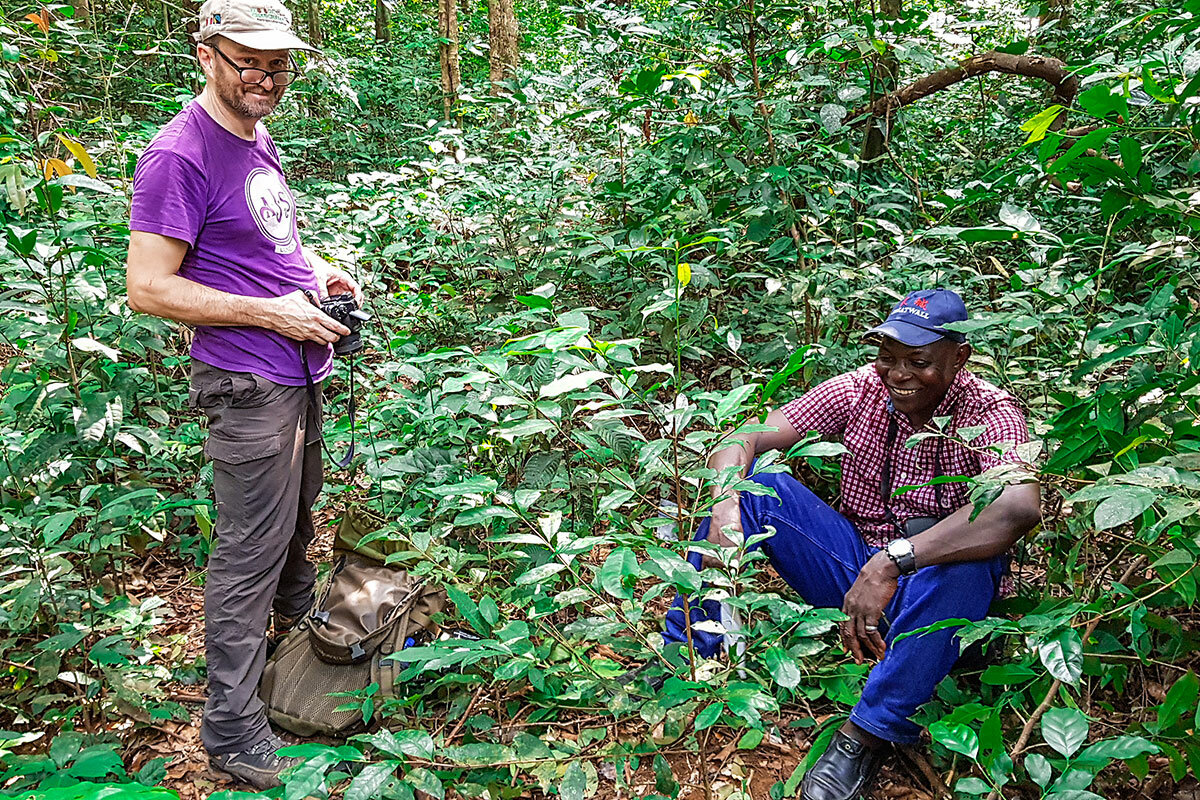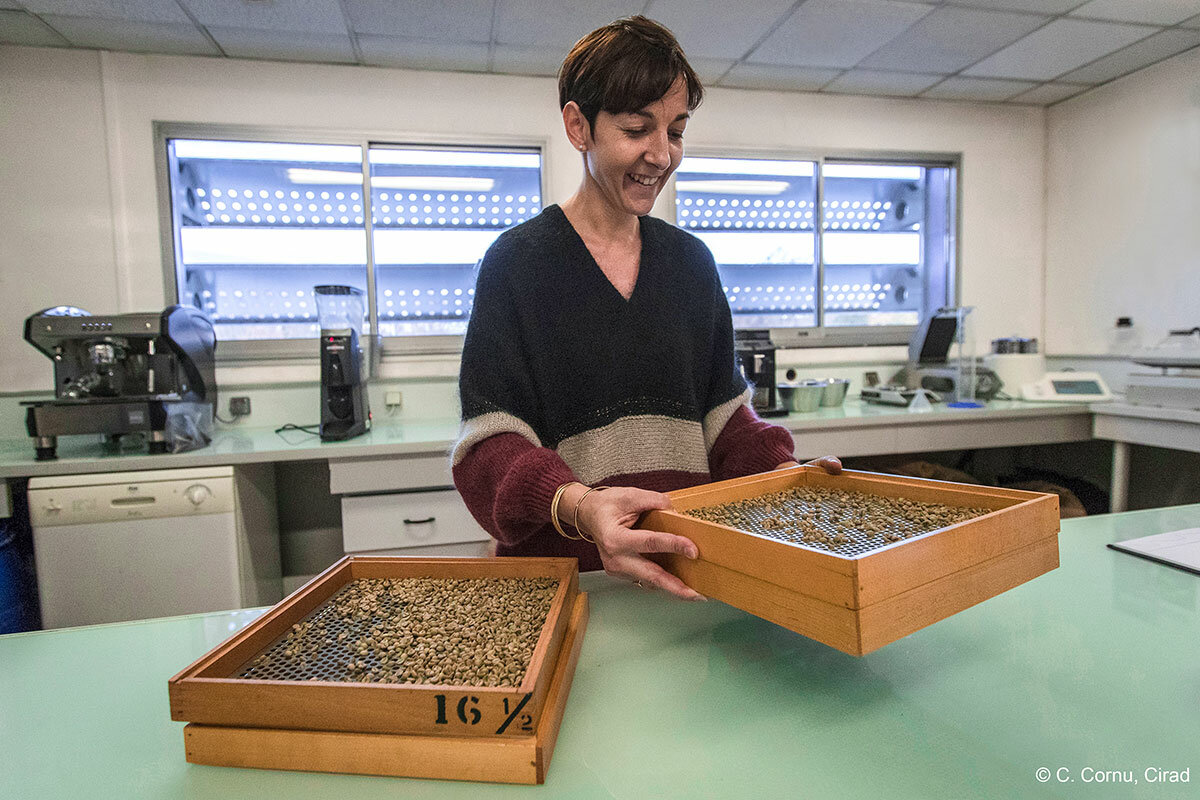Why this climate-resilient coffee may be just what farmers need
Loading...
| JOHANNESBURG
When Daniel Sarmu was growing up in eastern Sierra Leone, his family had two ways of making money: finding diamonds and growing coffee.
Both were grueling, uncertain kinds of work. Diamonds were, well, as rare as diamonds. Coffee, by contrast, grew hungrily in the region’s steamy, tropical rainforest climate. But the only kind of coffee that farmers like Mr. Sarmu’s family could grow was a variety called robusta. That’s the cheaper, lower-quality cousin of arabica coffee, which requires a milder climate. Sierra Leone was simply too hot.
“The price of robusta went up and down – sometimes you couldn’t even recoup the cost of your harvest,” Mr. Sarmu remembers.
Why We Wrote This
Climate change is making it harder for coffee farmers to make a living. This flavorful but long-forgotten variety of West African coffee grows in warmer temperatures, offering a potential solution.
Little did he know he would one day become part of a team that would hunt down a “forgotten” species of coffee that some say could change the game for farmers: stenophylla.
Stenophylla has the smooth, rich taste of the coveted coffee arabica but can grow at far higher temperatures. Since the search began in 2018, it’s been something of a botanical detective drama, with the team slashing its way through the Sierra Leone rainforest with machetes to find the elusive variety.
As the climate warms, scientists and development experts hope that hardier coffee species like stenophylla will help farmers in coffee-growing nations adapt and prosper.
“This is something unique that Sierra Leone can present to the world,” says Mr. Sarmu, now a coffee expert and development worker in Sierra Leone.
And the stakes of the project go beyond coffee.
“We may think, this is just a drink that we could – arguably – learn to live without,” says Aaron Davis, head of coffee research at the Royal Botanic Gardens, Kew in London. “But worldwide there are 100 million people involved in farming coffee. It’s their livelihood, their culture. There are entire countries that would fail if not for coffee.”
If scientists can find ways to help the small-scale farmers on the front lines of climate change thrive, they say the benefits will ripple across the world, from the global food supply to patterns of migration.
Dr. Davis has worked on the puzzle of how to climate-proof coffee in some form for more than a decade. A major part of that quest has been to find species of wild coffee that mimic the taste of those we already drink but grow more easily.
Although there are about 130 known species of coffee in the world, almost all of what we consume comes from the beans of just two – arabica and robusta.
Of those, arabica is by far the higher-value crop, powering most of the world’s cappuccinos and espressos. But it’s also a fickle plant. Originally found in the highlands of South Sudan and Ethiopia, it likes to grow in temperatures that hover around a mean of 66 degrees Fahrenheit. And in Central and South America it is susceptible to a blight called coffee leaf rust, which in recent years has destroyed massive harvests and at times triggered migrations from affected countries.
Robusta, on the other hand, is easier to grow in warmer climates but is particularly sensitive to drought.
So several years ago, Dr. Davis and his colleagues began trekking through coffee’s natural habitats – mostly scattered throughout Africa, with a few in South Asia – and poring over historical records and old plant samples. There, they came across stories of stenophylla, which had been grown in Sierra Leone until the turn of the 20th century. The last recorded sighting had been in the southern part of the country, in 1954.
Teaming up with Mr. Sarmu, they created a kind of “wanted” poster for the lost coffee and distributed it to farmers near the last known sighting.
A few thought they’d seen it, but when the scientists followed up, “nothing,” Dr. Davis says. The team turned up one lonely stenophylla plant near the last recorded sighting spot from the 1950s. But it wasn’t enough to work with.
So they headed across the country, to a spot near Mr. Sarmu’s hometown of Kenema where he thought conditions might be right. Then, they hacked their way through the forest with machetes for six hours. “We crossed streams and rivers, moving from hill to hill,” Mr. Sarmu says. “And then we saw the trees.”
But once they’d found the elusive coffee, there was still a major question.
Would it taste any good?
More than a year later, they got their chance to find out. Mr. Sarmu collected enough beans to roast a few cups’ worth of the stuff. Then he sent it to London, where it was put in front of a panel of coffee experts at Union Hand-Roasted Coffee.
Stenophylla passed their taste test with flying colors, rating as highly as specialty arabica blends.
“Arabica is currently our only specialty coffee species, and so this score, particularly from such a small sample, was surprising and remarkable,” Jeremy Torz of Union Coffee told Kew.
The next steps are to grow more of the stuff – coffee plants take four to seven years to fruit – and continue looking for the hardiest varieties.
Meanwhile, Dr. Davis and others are investigating other minor coffee species, hoping they’ll show similar potential, and also searching out hardier versions of arabica and robusta.
“Our coffee farmers are working in highly environmentally stressed conditions,” says Catherine Kiwuka, a conservationist with the National Agricultural Research Laboratories of Uganda, who did her Ph.D. research on drought-resistant varieties of robusta. “And when their crops fail, the consequences trickle through their society.”
She sees making coffee farming more resistant to warming weather as a moral imperative.
“People here don’t have any other options,” she says.









